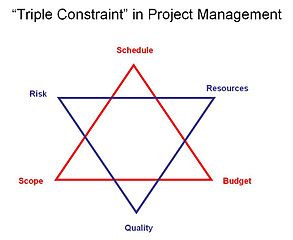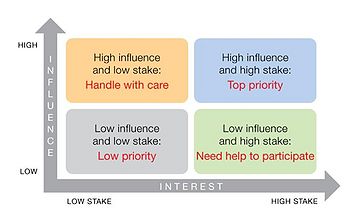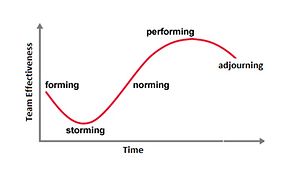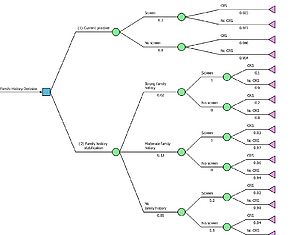Toolbox
| (5 intermediate revisions by 2 users not shown) | |||
| Line 44: | Line 44: | ||
Each list item should include Name of criteria, how it is going to be measured, how often it is going to be measured and who is responsible for measuring it. [j2] | Each list item should include Name of criteria, how it is going to be measured, how often it is going to be measured and who is responsible for measuring it. [j2] | ||
| + | ==Efficiency vs. Effectiveness== | ||
| + | |||
| + | Efficiency refers to how good the performance is, in the best possible way and with the fewest resources. While effectiveness refers to how useful something is, in order to achieve a goal that produces the intended or expected result. profitability refers to how good the performance is, in the best possible way and with the fewest resources. While effectiveness refers to how useful something is, in order to achieve a goal that produces the intended or expected result. | ||
| + | For example, a airplane is a very efficient means of transport, capable of moving people over long distances to specific locations, but an airplane may not effectively transport people because of the way it uses fuel. | ||
=People= | =People= | ||
| Line 80: | Line 84: | ||
In engineering, uncertainty is present in every new project as it is very difficult to exactly predict the exact outcomes that it will produce. This is a tonic in engineering as the information and data available is most of the times unreliable, because many predictions and forecasts must be performed. Furthermore, uncertainty leads to risk and some tools can help to achieve a proper study to be able to make the best decisions and be fully informed. Risk management, SWOT analysis and the decision tree are very powerful to obtain this. | In engineering, uncertainty is present in every new project as it is very difficult to exactly predict the exact outcomes that it will produce. This is a tonic in engineering as the information and data available is most of the times unreliable, because many predictions and forecasts must be performed. Furthermore, uncertainty leads to risk and some tools can help to achieve a proper study to be able to make the best decisions and be fully informed. Risk management, SWOT analysis and the decision tree are very powerful to obtain this. | ||
| + | |||
| + | ==PERT/CPM== | ||
| + | |||
| + | The Program Evaluation and Review Technique and Critical Path Method are network-based analysis that give the means to design and plan a project in great detail, in relation of the time a task needs to be completed, with the right hierarchy of task, adjusting the plan to the changes and the delays and last but not least the overall cost of the project. They developed intepentanly in the early ‘50s and they also used independently based on the nature of the problems. And that was because when those two methods were developed, there were up against problems of different nature. The PERT method used in problems with stochastic activity times and CPM in problems with deterministic time. But nowadays those differences do not exist and so the two methods have emerged with one another in a common method which is called PERT/CPM method. | ||
==Decision tree== | ==Decision tree== | ||
| Line 102: | Line 110: | ||
• Start to Finish SF | • Start to Finish SF | ||
These conditions differ depending on the identity and needs of each task as shown in Figure 4. Approaching a procedure with the predecessors and the successors logic in tasks will analytically visualize critical assessments. Dividing a complex matter into smaller subparts aids with the demonstration of allocation, period and dependencies. The discipline to finish tasks in time is a keynote for the total success of a complex project, while it is easily implementable through front-end software. | These conditions differ depending on the identity and needs of each task as shown in Figure 4. Approaching a procedure with the predecessors and the successors logic in tasks will analytically visualize critical assessments. Dividing a complex matter into smaller subparts aids with the demonstration of allocation, period and dependencies. The discipline to finish tasks in time is a keynote for the total success of a complex project, while it is easily implementable through front-end software. | ||
| + | |||
| + | |||
[[File:gc.jpg|thumb|Figure 3: Gantt Chart Example |200px]] | [[File:gc.jpg|thumb|Figure 3: Gantt Chart Example |200px]] | ||
Latest revision as of 20:28, 8 March 2020
Contents |
[edit] Purpose
[edit] Business case
The business case is the document that contains the most relevant information about the project and it represents the justification for the business. The crucial information it has to contain is the reasons, options, benefits and dis-benefits, timescale, cost, major risks and opportunities.
When defining a business case it is necessary to define the schedule, risk, resources, budget, quality and scope. These five main areas define the called Six Star Constraint Model.

There are three main tools to define the business case, its definition can be followed below:
- Cost/benefit analysis: it serves to quantify if the difference between the cost and the expected revenue [1].
- Payback period: its objective is to compare the revenue generated each year and the initial investment to obtain the profit.
- Net Present Value (NPV): it is an indicator of the feasibility of the project. It is the difference between the present value of cash inflows and the present value of cash outflows over some time [2].
[edit] Feasibility study
A feasibility study is an analysis whose objective is to get the likelihood of project success. It takes into account the most relevant influence factors. These factors are the following: [3]
- Technical: it focuses on the technical resources and helps the organisation determining if the technical team can deal with the technical challenges.
- Economic: it involves cost-benefit analysis and helps the organisation to check the feasibility of the project.
- Operational: its objective is to establish the organisation to accomplish the objectives.
- Legal: it takes into account all the framework to find is there are any conflicts between it and the project.
- Scheduling: its objective is to estimate how much time the project will take to complete [4].
[edit] Success criteria
Standards that will be used to judge if a project has been successful or not by the eyes of the stakeholders at the end of it. There are two components to clarifying the definition of project success: project management success and product success. Project management success has as a goal to achieve cost, time and quality objectives. Product success focuses on the final product of the project. To find success at the end of a project is needed to identify what is a success for you and the stakeholders. Example of success standards: [j1]
- Hold a project board meeting once a month.
- Complete project audits in line with the timetable.
- Reach the deadlines.
Each list item should include Name of criteria, how it is going to be measured, how often it is going to be measured and who is responsible for measuring it. [j2]
[edit] Efficiency vs. Effectiveness
Efficiency refers to how good the performance is, in the best possible way and with the fewest resources. While effectiveness refers to how useful something is, in order to achieve a goal that produces the intended or expected result. profitability refers to how good the performance is, in the best possible way and with the fewest resources. While effectiveness refers to how useful something is, in order to achieve a goal that produces the intended or expected result. For example, a airplane is a very efficient means of transport, capable of moving people over long distances to specific locations, but an airplane may not effectively transport people because of the way it uses fuel.
[edit] People
Regarding project management, it is very important to understand the people involved and their individual interests towards it.
[edit] Stakeholder map
Stakeholders are people interested in a company or a project and can be affected directly or indirectly from it. In every engineering project, it is necessary to manage properly the people involved, such as investors, suppliers, clients and line managers, because each of them has a distinct interest in the completion of the same. It is very important to do this after identifying the purpose of the project, otherwise, a wrong understanding of stakeholders can occur [h1]. A stakeholder map is an ideal tool to accomplish this and have every part involved internally and externally in the project satisfied. All stakeholders are not the same, they have different influences and interest surrounding the project. Commonly, stakeholders are differentiated or classified depending on three criteria: power, legitimacy and urgency [h2]. Stakeholders mapping can lead to many results and outcomes, and it is important to focus the outcomes to achieve a proper stakeholder engagement at all levels. Besides, improving stakeholder affinity, that depends on power and interest, is a crucial point to take into account. Some stakeholders have more influence than others and it is mandatory to recognize this utilizing stakeholder mapping as well. A matrix where each and every stakeholder is classified is what the method suggests [h2]:

From the matrix, it is intuitive to find the stakeholders that have a higher influence. From this, it is deducted that a higher priority has to be given to them to make sure they have their demands satisfied. This can be done after the analysis of all the stakeholders. The most typical vias to integrate stakeholders are buffering, co-optation, mutual learning and meta-problem solving [h3].
[edit] Team development
The people in the team must be able to work together but depending on their knowledge will contribute in different ways. The teams go through stages from being unknown to have a united group. The team development toll describes five stages: Forming, Storming, Norming and Performing.
- Forming: Positive and polite environment. Two positions. Unknown members: Don’t understand what they are working with. Excited members: Full energy in the task. Uncertain time.
- Storming: Members start to push against the boundaries, creating conflicts due to ways of working, goals and competition as individuals. Members must work accepting individual differences and going through the obstacles.
- Norming: The conflict is resolved and the unity emerges. The team starts to socialize, ask for help and provide feedback.
- Performing: The team is established, being more mature, organized and well-functioning. The team is more committed to the mission but conflicts can emerge.
- Adjourning: The goals are achieved and the team should wrap up the tasks and document the results. The process of a team has been finished.

[edit] Uncertainty
In engineering, uncertainty is present in every new project as it is very difficult to exactly predict the exact outcomes that it will produce. This is a tonic in engineering as the information and data available is most of the times unreliable, because many predictions and forecasts must be performed. Furthermore, uncertainty leads to risk and some tools can help to achieve a proper study to be able to make the best decisions and be fully informed. Risk management, SWOT analysis and the decision tree are very powerful to obtain this.
[edit] PERT/CPM
The Program Evaluation and Review Technique and Critical Path Method are network-based analysis that give the means to design and plan a project in great detail, in relation of the time a task needs to be completed, with the right hierarchy of task, adjusting the plan to the changes and the delays and last but not least the overall cost of the project. They developed intepentanly in the early ‘50s and they also used independently based on the nature of the problems. And that was because when those two methods were developed, there were up against problems of different nature. The PERT method used in problems with stochastic activity times and CPM in problems with deterministic time. But nowadays those differences do not exist and so the two methods have emerged with one another in a common method which is called PERT/CPM method.
[edit] Decision tree
The decision tree is a very powerful tool to analyze the different decisions and outcomes that can be taken in a project utilizing a tree-like model. It defines the probabilities for each of the possibilities. This way it is possible to determine the expected future for each of the scenarios. One of the main disadvantages is that one change in the data can change all the possible outcome and therefore the route to follow [h7], including that these trees can become very complex.

[edit] Complexity
The underestimation of a project’s complexity is directly linked to its failure. The consequences of complexity is a stochastic procedure thus its extremely difficult to be avoided or controlled. The direct link to the uncertainty is often overlooked because the environment of an engineering project under development is constantly changing. Attempting to reduce the causes of a certain complex node is not a sufficient method of confrontation. The complexity footprint to be set in each project is dependent on the balance and the analysis level on the majority of the interlinked elements, extending to their intricate interactions and synergy. To commence a successful managerial attempt the main drivers must be recognized from their subjective grade and their dynamic effect. Adaptability and co-forming the framework is mandatory to increase the chances of improved decision-making in a developmental phase of a project. To figure the proper assessment of an engineering project, certain strategic managerial tools must be implemented in a versatile alignment, meaning that they should not be used compulsorily in the order they are referred to. Due to the high polymorphic engineering developmental spectrum, this specific chain of tools is an attempt to finding a common denominator and pattern for the early stages of a project.
[edit] Gantt Chart
Emphasizing on the assessment of complexity and set a basis the Gantt Chart must be utilized. The need to schedule and differentiate the tasked required is fulfilled by the structure of the chart. Bars are horizontally placed illustrating the duration of each individual process setting demands, hierarchy and limitation to the subtotal picture. The possible dependencies among the tasks are separated into the following categories depending on their level of importance and completion demands: • Finish to Start FS • Start to Start SS • Finish to Finish FF • Start to Finish SF These conditions differ depending on the identity and needs of each task as shown in Figure 4. Approaching a procedure with the predecessors and the successors logic in tasks will analytically visualize critical assessments. Dividing a complex matter into smaller subparts aids with the demonstration of allocation, period and dependencies. The discipline to finish tasks in time is a keynote for the total success of a complex project, while it is easily implementable through front-end software.
[edit] Life Cycle Model
To define the criteria and the expected results for each phase, demonstrated by the general framework, the Life Cycle Model can emerge as a common denominator. Allowing the evaluation of technical systems depending on their chronological position in the total life cycle provides a theoretical structure to commence or continue a case analysis. The general divide can be established by the following cornerstone stages and the connectivity in between is set by the decision gates that exist at the end of one phase and the start of the other. After each step, there is a case example to evaluate the emerged quality. The development phase is one of the most crucial since the decisions made are so early that affect the total image. Realization Phase covers the transition phase between development and utilization divided into two steps. First, the system realization that includes transformation tasks of the concept and secondly the implementation and installation of the guidelines. Utilization phase is an operative procedure fully monitored by a suitable performance system that tracks any deviations. Disposal Phase is the decomposing phase of a project. Total removal or total redesigning of a case can be established depending on the scale of the demand and the activity cycle. Variations of these stages can exist related to the root and nature of the special condition of each engineering project. In the context of sustainability is establishes a backbone for straightforward risk and environmental impact throughout the holistic view of a system.
[edit] References
[1] https://youtu.be/bDAsAbMMep0, Procurement Academy 2015, Business Case - Definitions [2] https://www.investopedia.com/terms/n/npv.asp [3] https://www.investopedia.com/terms/f/feasibility-study.asp [4] https://www.simplilearn.com/feasibility-study-article [5] https://www.google.com/search?q=Six+Star+Constraint+Model&sxsrf=ALeKk01pjWlR-dv-zceA2NRuOVZlmDn4AA:1582289819396&source=lnms&tbm=isch&sa=X&ved=2ahUKEwjCn_f02OLnAhWJqIsKHZYcBPAQ_AUoAXoECAwQAw&biw=965&bih=742#imgrc=Hx8rVvdQQUeDXM [4] https://www.investopedia.com/terms/f/feasibility-study.asp [h1] http://wiki.doing-projects.org/index.php/Stakeholder_Management [h2] https://www.stakeholdermap.com/ [h3] https://www.researchgate.net/figure/Typology-of-Stakeholder-Integration-Mechanisms_fig1_254800916 [h4] https://www.investopedia.com/terms/s/stakeholder.asp [h5] https://www.iaea.org/resources/nuclear-communicators-toolbox/methods/planning/stakeholder-analysis [h6] https://conceptdraw.com/a1917c4/preview [h7] https://www.ncbi.nlm.nih.gov/pmc/articles/PMC5767274/ [j1] https://www.girlsguidetopm.com/the-definitive-guide-to-project-success-criteria/ [j2] https://www.pmi.org/learning/library/project-success-criteria-opinion-counts-1010 [j3] https://www.mindtools.com/pages/article/newLDR_86.htm [j4] https://www.youtube.com/watch?v=nFE8IaoInQU [j5] https://courses.lumenlearning.com/suny-principlesmanagement/chapter/reading-the-five-stages-of-team-development/
Cite error:
<ref> tags exist, but no <references/> tag was found
